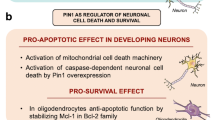Abstract.
Protein phosphorylation on serine or threonine residues preceding proline (Ser/Thr-Pro) plays an essential role for regulating various cellular processes, including cell cycle progression. Although phosphorylation has been proposed to regulate the function of a protein by inducing conformational changes, much less is known about what phosphate additions actually do and how the functions of phosphoproteins are coordinated. Proline is important for determining protein structure because it exists in cis or trans conformation and can put kinks into a polypeptide chain. We have shown that phosphorylation on Ser/Thr-Pro motifs reduces the cis/trans isomerization rate of Ser/Thr-Pro bonds. At the same time, proteins containing phosphorylated Ser/Thr-Pro motifs are substrates for the prolyl isomerase Pin1. The WW domain of Pin1 acts as a phosphoserine/threonine-binding module binding a defined subset of mitosis-specific phosphoproteins, such as Cdc25 and tau. These interactions target the enzymatic activity of Pin1 close to its substrates. In contrast to other prolyl isomerases (peptidyl-prolyl isomerases, PPIases), Pin1 has an extremely high degree of substrate specificity, specifically isomerizing phosphorylated Ser/Thr-Pro bonds. Therefore, Pin1 binds and regulates the function of a defined subset of phosphoproteins. Furthermore, inhibiting Pin1 function is lethal for dividing cells. Interestingly, Pin1, which can restore the biological function of phosphorylated tau, is sequestered in the neurofibrillary tangles in Alzheimer’s brains. Thus, we have proposed a novel signaling regulatory mechanism, where protein phosphorylation creates binding sites for Pin1, which can then latch on to and isomerize the phosphorylated Ser/Thr-Pro peptide bond. In turn, this may change the shape of the protein, regulating its activity, dephosphorylation, degradation or location in the cell. This new post-phosphorylation regulatory mechanism appears to play an important role in normal cell function, such as mitotic progression, and in the pathogenesis of some human pathologies, such as Alzheimer’s disease.
Similar content being viewed by others
Author information
Authors and Affiliations
Additional information
Received 10 June 1999; received after revision 2 August 1999; accepted 13 August 1999
Rights and permissions
About this article
Cite this article
Zhou, X., Lu, PJ., Wulf, G. et al. Phosphorylation-dependent prolyl isomerization: a novel signaling regulatory mechanism. CMLS, Cell. Mol. Life Sci. 56, 788–806 (1999). https://doi.org/10.1007/s000180050026
Issue Date:
DOI: https://doi.org/10.1007/s000180050026




